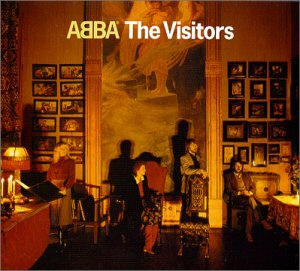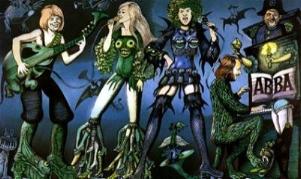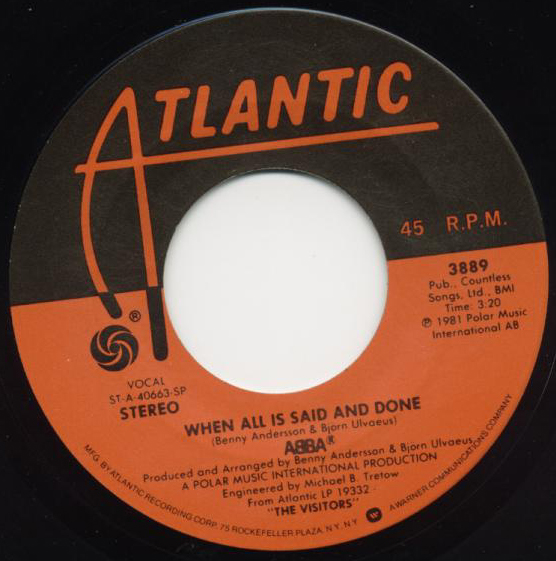
By Donnie Thompson
While I nodded, nearly napping, suddenly there came a tapping, As of some one gently rapping, rapping at my chamber door. "Tis some visitor," I muttered, "tapping at my chamber door"… Edgar Allan Poe – "The Raven" 1845
" A catchy chorus or two cannot hide the fact that Abba is in a slump" claimed a review of Abba’s "The Visitors" by a major music magazine in 1981. Often dismissed as an album by a band that was tired and out of ideas by critics, "The Visitors" in actuality is Abba offering up their darkly beautiful swan song. Book- ended by two songs that in scenario, seem to draw inspiration from Edgar Allen Poe’s gothic poem "The Raven", the album begins with the eerie title song (subtitled on the lyric sheet "Crackin’ Up"). The track starts with a droning synthesizer. After 30 seconds lead singer Frida’s voice rises up out of the mix sounding very compressed, a lot like Lennon’s on The Beatles "Tomorrow Never Knows". Frida had spent fifteen days before the session experimenting with her voice trying to replicate the sound of a sitar. We find the lead character of the song locked in her room among her books and paintings frozen in a panic as some mysterious visitors are ringing her bell trying to gain entry. The enigmatic lyric of this song kept me curious for several years as to it’s subject. I assumed by the sub-title that it concerned someone who had lost a few wits and was about to be taken away. Although it fits well on that level, it was around 1987 that another music collector informed me that the song was actually a veiled story about Soviet dissidents. The third verse goes: These walls have witnessed all the anguish of humiliation And seen the hope of freedom glow in shining faces And now they’ve come to take me, come to break me And yet it isn’t unexpected I have been waiting for these visitors Help me The second track is the upbeat hook- filled "Head Over heels". Beginning with one of Benny Andersson’s catchiest neo- classical synth riffs ever, the song tells about a gregarious woman, admired by all who know her. But by the second verse we learn she is the domineering half of a dysfunctional relationship with her man. Of the album, this track is probably the closest in sound and playfulness to the Abba of old. With it’s great layered harmonies it became a moderate hit in Europe. Next up is "When All is Said And Done" which was pulled as the single in the U. S. The track has a Euro-dance-synth type arrangement with some electronic vocal effects alongside the traditional Abba harmonies. It’s basically a farewell by a couple who are shaking hands and parting ways: Here’s to us, one more toast And then we’ll pay the bill Deep inside both of us Can feel the autumn chill Abba had touched on this theme before in "Knowing Me, Knowing You" and "The Winner Takes It all". It seems fitting that this song would be Abba’s final top 40 hit in the U. S. Though not as sterling in quality as the previous tracks, "Soldiers" continues the lyrical anxiety of the first track, this time painting pictures of impending political unrest and war. Played over an unusual mid-tempo drum pattern the song comes across like a vague sequel to "Fernando". The next track up "I Let The Music Speak" is one of the most stunningly beautiful in the entire Abba canon. Coming across much like a Broadway show tune with heavy classical influences, the song’s subject matter is about music being a means of expression and of escape to a place… "Where I’m one with every grand illusion, no distractions, no intrusions" Decorating the track with a gorgeous orchestral- like arrangement, Benny and Bjorn eagerly drive Abba toward their own ambitions of a full-blown musical. They had dabbled with this genre before (" The Girl With The Golden Hair") but not with this much finesse and eloquence. "One Of Us" contains another classic Abba melody and carries on with the album’s theme of separation. This mid-tempo ballad about regrets over an ended relationship was a hit in Europe. This is one that you will find yourself humming hours after you’ve heard it. The following track "Two For The Price Of One" tells the story of a man perusing the matrimonial advertising pages. Although it was obviously meant to be the album’s light- hearted novelty tune with a cute story, The character in the song is still a lonely railway worker…" with no romance in his life, sometimes he wished he had a wife" . He still comes away with his situation unresolved in the end. "Slipping through My Fingers" concerns a mother’s wistful contemplations of her relationship with her daughter who she fears is drifting away from her too quickly as the girl reaches school age and heads out into the world. Abba had attempted this kind of cinematic "lump in throat" ballad before, but due to this one’s more common yet personal subject matter, it comes off less contrived and more poignant. The song ends with the coda: Schoolbag in hand She leaves home in the early morning Waving goodbye with an absent minded smile And once again our protagonist is left alone with her thoughts and memories as the song cross-fades into the next track. "Like An Angel Passing Through My Room" begins with the sound of a ticking metronome creating a clock- like effect and a music-box sounding keyboard to back Frida’s lone vocal. The track is solemnly beautiful. Several different arrangements were taped before this haunting stripped-down version was chosen. Sitting in the glow of the fireplace the character begins to reminisce: Half awake and half in dreams Seeing long forgotten scenes So the present runs into the past Now and then become entwined Playing games within my mind Like the embers as they die Love was one prolonged goodbye And it all comes back to me tonight In the gloom Like an angel passing through my room The lyric works on several levels. It could be about the end of a day, the end of a relationship, or the end of a life. With the lead character alone and detached from reality, the song brings the album back to where it started. After Frida’s vocal, the keyboard fades to just the ticking metronome. A few seconds later it stops abruptly, and we’re left alone in the silence. The ending is quite effective. The cover art also lends itself to the somber mood of the music. No longer do we see the happy smiling Swedish superstars huddled together. Instead we find them in a gothic looking gallery seated apart from each other all looking as if they are waiting for someone to yell "cut, that’s a take". Behind them, in a very large painting, an angel, perhaps like the one in the last song, sadly looks down on the disintegrating pop group. Whether or not Abba consciously set out to make this album hang together like it does is known only to them and those involved. The break- up of the two couples and ultimately the band, added an edge and maturity to Abba’s music that is unique to this album. "The Visitors" along with the rest of Abba’s catalog has been re-issued on C. D. The new C. D. version adds four "Visitor" era single sides as bonus tracks.

